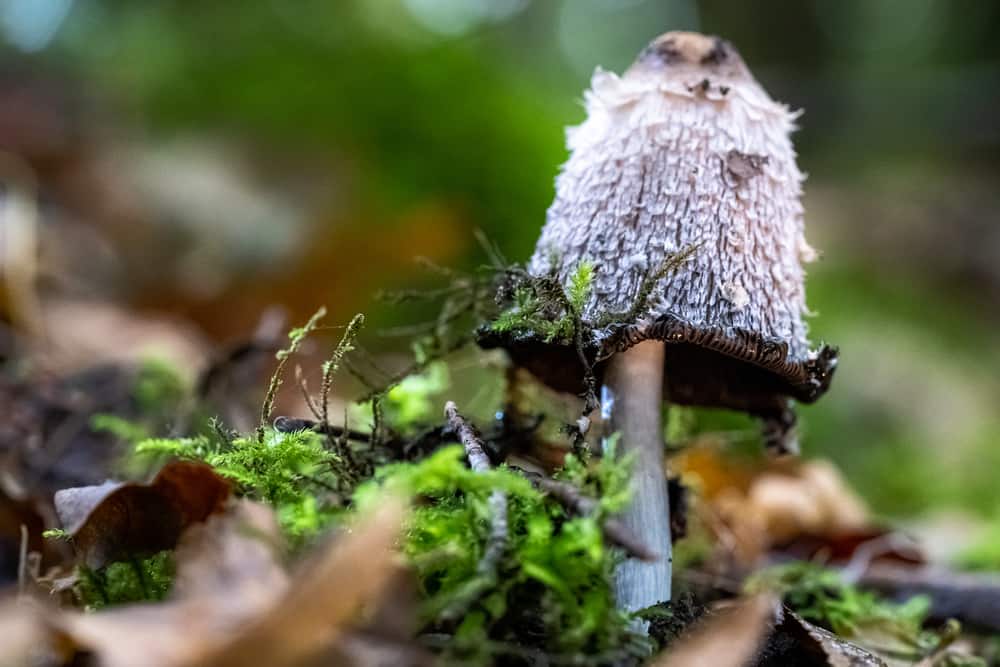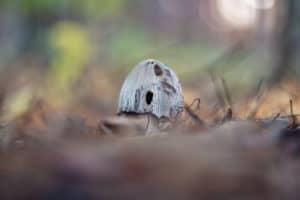All About Inky Caps
Inky caps are a fascinating mushroom type found around the world. They are most well known for their distinctive black gills, and their likelihood to liquefy into a mass of black goo before you get them home. The inky cap name is well-deserved as that goo was used as actual ink at times.
Are Inky Caps edible?
Many types of inky caps are edible, but not all of them. There are two main varieties sought out by foragers in North America: Common Inky Caps and Shaggy Manes.
Common Inky Caps (Coprinopsis atramentaria)
This determined little mushroom is widespread throughout the northern hemisphere. Common inky caps grow on decaying wood in disturbed areas, on lawns, and in fields. They are commonly found in the unlikeliest of areas, including cracks in asphalt and cement and the middle of the Sonoran desert.
The wood they are growing from is often buried and not visible unless dug up. Most often, it looks like they are growing from the soil or grass.
These fungi are small, with bell-shaped gray to blackcaps, and thin, spindly stems. The flesh of the cap is thin, and they have jet-black gills. As they age, the cap flattens, and the entire mushroom disintegrates. This often happens within a day or two.
Inky caps often grow in clumps or groupings, and they can be found spring through autumn. They are known to fruit several times a year in the same spot, especially during rainy times.
Is the inky cap poisonous when eaten with alcohol?
The common inky cap is also referred to as tippler’s bane because if consumed with alcohol, the mushroom becomes poisonous. That’s right; do NOT eat this mushroom while drinking alcohol. Or, within three days of drinking alcohol as symptoms still may occur. The most common symptoms are nausea, vomiting, sweating, diarrhea, palpitations, and tingling.
Are inky caps psychedelic?
No.
Does the common inky cap have look-a-likes?
There are many small, parasol-capped, fungi that, at first glance, resemble inky caps. The main distinction is the black gills. If you see any black goopy decomposition, you’ll know for sure it’s an inky cap.
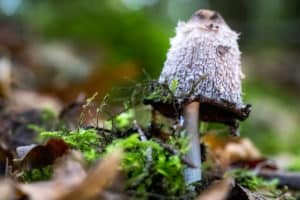
Shaggy Manes (Coprinus comatus)
Also known as lawyer’s wig or shaggy ink cap, this mushroom is a delicacy if foraged when young. It is common across many parts of the world, including North America, Australia, Europe, and Iceland. Shaggy manes grow in grass and meadows, disturbed areas, woodpiles, and are often found in urban areas growing in parks and along roadsides.
The name shaggy mane comes from the distinctive white scales that adorn the long, cylindrical cap. The stem is long (1-7” tall), white, hollow, and has a loose ring around it. It’s gills start out white, yet quickly turn to black with age.
Shaggy manes, like the common inky cap, deteriorate quickly, going from pure white to a mess of black sludge in a matter of days. All parts of the mushroom are fragile and will break easily, even when young.
Shaggy manes fruit in summer and fall after a rainfall. They grow singularly, in groups, and in fairy rings. After a period of rain, they are often prolific.
Is the shaggy mane mushroom poisonous?
No. Unlike the common inky cap, shaggy manes are safe to consume with alcohol and will not make you sick.
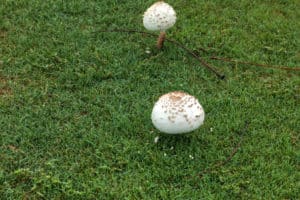
Does the shaggy mane have look-a-likes?
Yes, two mushrooms are sometimes mistaken for the shaggy mane by inexperienced foragers. The shaggy parasol (Chlorophyllum rhacodes) has a fleshy white cap which is egg-shaped when young and is covered with brown scales. The cap flattens out with age, distinguishing it from the shaggy mane. Also, the scales are brown instead of white.
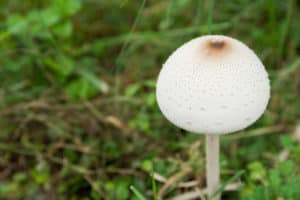
The false parasol or vomiter mushroom (Chlorophyllum molybdites) is the most common cause of mushroom poisoning in North America. It also features an egg-shaped white cap with shaggy brown scales when young. As it ages, the cap flattens out, which immediately makes it clear it is not a shaggy mane.
Foraging and Preparing Inky Cap Mushrooms
Because inky cap mushroom varieties disintegrate quickly, they should be consumed the same day they are picked. Otherwise, you may find yourself only with a bag of inedible black goop. Shaggy manes, in particular, will begin turning black within hours of being picked. If the mushrooms show any sign of darkening around the edges, do not forage them.
Specimens must be young, show no signs of decay, and stored in a place where they won’t receive any bruising. If you are out on a hike, this can be difficult. Placed in a bag or basket on their own is best, yet any bumps, bruises, or squishing they receive will start decomposition immediately. If you are specifically foraging shaggy manes or inky caps, bring a separate basket or box for them to transported gently.
Is there any way to prolong the keeping of Inky Cap mushrooms?
Cooking the mushrooms until they are limp allows for them to be stored several days in the refrigerator without decaying. Popular cooking methods include sauteing, simmering, and microwaving. They must be used within a few days after cooking, though. Inky caps can be frozen after cooking, too.
Putting shaggy manes on ice, or in ice water, within four to six hours of being foraged, prolongs their edibility for a couple of days.
Can common inky caps or shaggy manes be eaten raw?
Shaggy manes are eaten raw in some cultures. We do not recommend eating them raw.
How Do You Make Ink From Inky Caps?
The process is quite simple; however, be prepared for the smell. It’s quite intense and not at all pleasant. For a unique (and free!) ink, it’s a fun project, though.
- Collect inky cap mushrooms.
- Place mushrooms in a glass jar and wait for them to decompose. It’s best to do this in a secluded place to avoid the smell.
- Strain the mixture several times to get a smooth liquid.
- Add a couple of drops of essential oil before using it to alleviate the smell.

